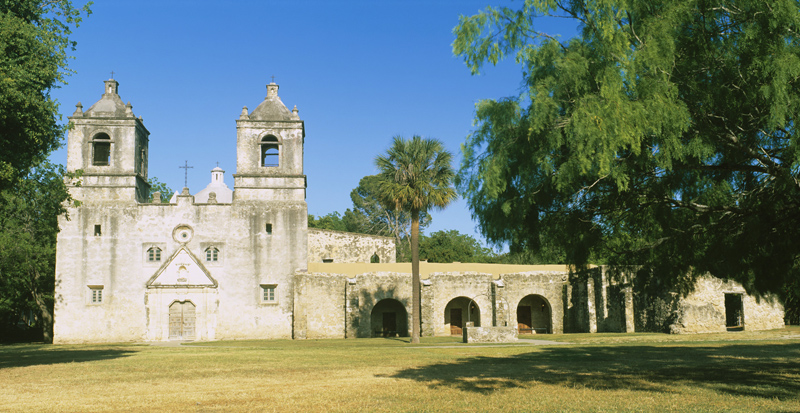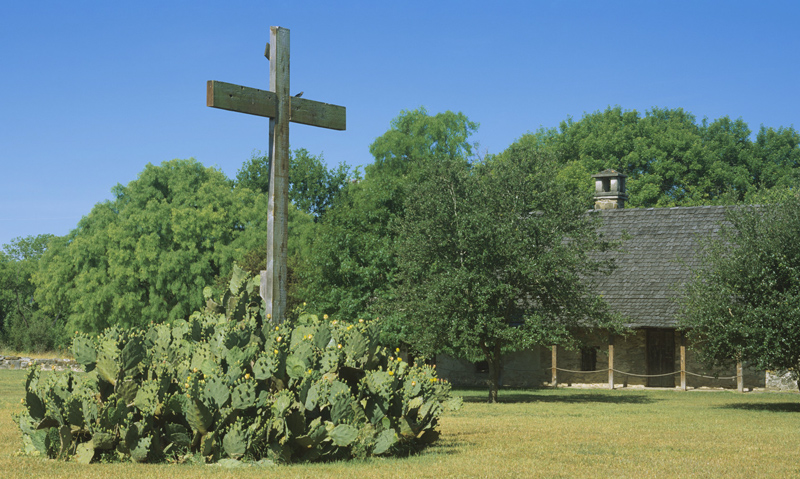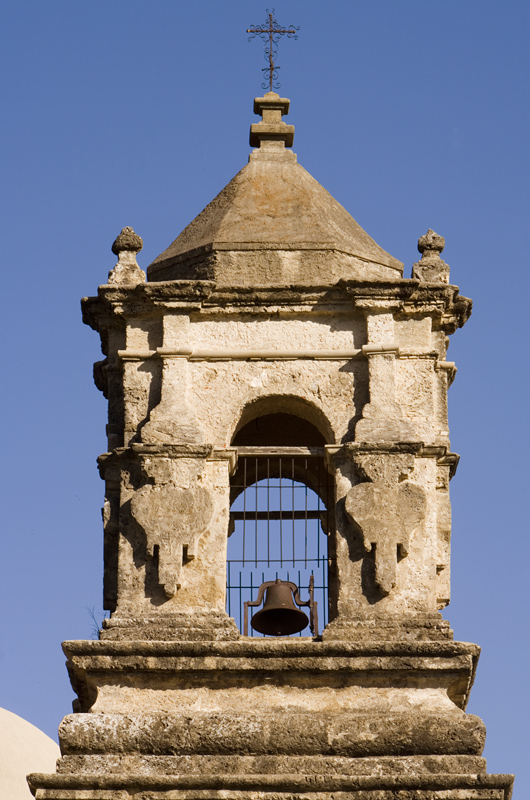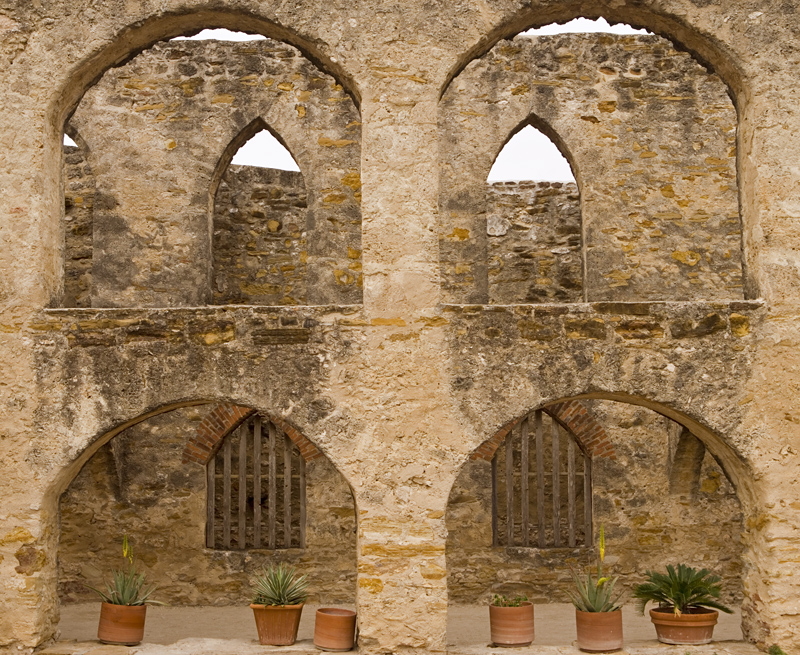< San Antonio & Austin's Top 10
 San Antonio Missions National Historical Park
San Antonio Missions National Historical Park
Six missions established by Spain in the early 18th century formed the settlements around which the city of San Antonio grew. They were established between 1718 and 1731 for political as well as religious reasons: Spain wanted to stop France from spreading west beyond Louisiana, and to convert the Native Americans to Roman Catholicism. Threatened by drought, disease, and hostile tribes the Native Americans helped build the missions in exchange for protection.
Top 10 Features
 Mission Concepción Church
Mission Concepción Church

Mission Concepción church
The church at Mission Nuestra Señora de la Purisima Concepción de Acuña is the oldest unrestored stone Catholic church in the US. Built on bedrock, the chapel was completed in 1755.
 Frescos at Mission Concepción
Frescos at Mission Concepción
Some of the colorful frescos here were purely decorative, while others helped to teach Catholicism. Today, the few complete ones show a blend of Christian, Spanish, and Native artistic styles.
 Mission San José
Mission San José
The largest of the San Antonio missions was founded in 1720 by Franciscan missionary, Father Antonio Margil de Jesús. It has been restored to look like it did in 1790.
 Native American Quarters at Mission San José
Native American Quarters at Mission San José
The huge flat-topped stone walls were built wide enough to house two-room apartments for indigenous families. By 1768, 350 Native Americans lived in the complex. The men worked in the fields, and in other trades necessary to sustain the mission.
 Mission Espada Church
Mission Espada Church
In 1731, Mission San Francisco de la Espada was relocated from East Texas to its current location along San Antonio River. The church with its three-bell tower was completed in 1731. Franciscans live and work in the convento today.
 Mission San Juan
Mission San Juan

Established in 1736, the mission was surrounded by fertile fields growing corn, beans, and sugarcane. By the mid-1700s it traded goods as far east as Louisiana, and south to Coahuila, Mexico.
 San Juan Acequia
San Juan Acequia
Missionaries found that the acequias, or aqueducts, brought to Spain by the Romans and Moors also worked well in the Texan heat. Seven miles 11 km of acequias gave water to San Juan, and gateways controlled the water-flow.
 Espada Dam
Espada Dam
The oldest continuously used Spanish-built diversion dam in Texas has provided water for irrigation since 1745. Engineered by Franciscan missionaries and built by the Native American converts the dam was originally 270 ft 82 m long and 8 ft 2 m high.
 Mission Espada Grounds
Mission Espada Grounds
This was the only San Antonio mission where tiles and bricks were made. The bricks made here were of wide, thin, Roman style, and can still be seen in old walls and buildings. Most of the buildings were destroyed in a fire.
 Espada Aqueduct
Espada Aqueduct
A remarkable engineering feat, this is the oldest functioning Spanish colonial aqueduct in the US and was completed in 1745. Water diverted from the river flowed through an acequia, and entered the aqueduct to cross Piedras Creek. It continued on, to irrigate the fields of Mission Espada.
Tip: A lively Mariachi Mass is held at 12 noon every Sunday at Mission San José.
Tip: Free guided tours are offered daily at each mission. Check for timings.
Tip: For a fast lunch try Bill Miller Bar-B-Q on the corner of Roosevelt Ave. and SE Military Drive near Mission San José.
Mission Trail
Visitor Information
- Mission Concepción
- 807 Mission Rd
- Mission San José
- 6701 San José Dr at Mission Rd
- Mission San Juan
- 9101 Graf at Ashley
- Mission Espada
- 10040 Espada Rd
- Open 9am–5pm daily
- Partial dis. access
- www.nps.gov/saan
< San Antonio & Austin's Top 10
 Mission San José
Mission San José
 Church Façade
Church Façade

Statue at entrance
The imposing façade with its bell tower is famed for its elaborate, asymmetrical appearance. The lavish entryway displays six carved stone statues of saints. Of these, Saint Joseph, the mission’s patron saint, stands above the entrance.
 Carved Symbols
Carved Symbols
Spanish artisans carved intricate teaching symbols into the façade. The thorn-enclosed heart represents Christ’s love for humanity, revealed through his pain. Some of the angels, the heavenly messengers, have Native American features.
 Rose Window
Rose Window
This window is one of the highlights here. One legend tells of the sculptor lovingly working on “Rosa’s Window” for years, lamenting his dead sweetheart.
 Bell Tower and Stairway
Bell Tower and Stairway

Bell Tower
Legend says that when the choir-stairway in the Bell Tower collapsed in 1903, each parish family kept one step until repairs were complete. The stairs were put back in place afterwards.
 Sacristy Doors
Sacristy Doors
The carved pomegranates on these cedar doors, depicting seeds within the fruit, symbolize the Church’s unity, while the red juice is Christ’s blood.
 Convento Ruins
Convento Ruins
The two-story convento housed the missionaries. Gothic arches were introduced in 1861; the Spanish arches are original.
 Museum and Soldiers’ Quarters
Museum and Soldiers’ Quarters
Housed in the former soldiers’ quarters, this small museum chronicles the history of the mission from its beginning to the time after it was secularized in 1824.
 Granary and Diorama
Granary and Diorama
The large granary features external flying buttresses, which supported the long walls. Today, there is an excellent diorama of the mission with a five-minute narration of a typical day.
 Grist Mill
Grist Mill
Wheat was introduced to replace corn, which the Spanish thought inferior. The restored mill still operates, using the unusual horizontal water wheel. The mill was designed to use water from the acequia for power.
 Quadrangle
Quadrangle
This large open area inside the mission walls was used for many daily activities. Native women did their baking in the communal ovens located near their apartments, children were instructed in Catholicism, and the men practiced with their rifles as they trained to protect the mission.
Father Margil, “Apostle of Texas”

Gothic and Spanish arches
Antonio Margil de Jesús was born in Valencia, Spain, in 1657. His devotion to the church became apparent at an early age and he became a Franciscan in 1673. Margil received holy orders in 1682 and volunteered for an assignment to do missionary work in New Spain in 1683. He was stationed at the famous missionary college of Santa Cruz, Querétaro, but traveled extensively, visiting missions in Yucatan, Costa Rica, Nicaragua, and especially in Guatemala earning him the name “Apostle of Guatemala.” Margil traveled to East Texas with the expedition of Domingo Ramon in 1716, and became known as the “Apostle of Texas.” From his earliest days in New Spain, he always walked barefoot, fasted every day, never ate meat or fish, and adhered to strict self-discipline. He slept for short periods, and prayed through the night. His efforts for the betterment of Native Americans and colonists were crowned with extraordinary success.